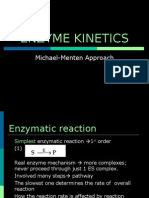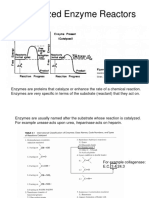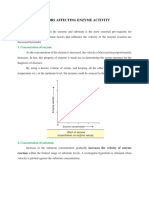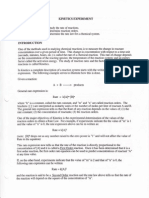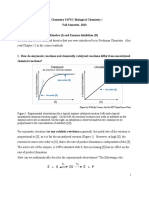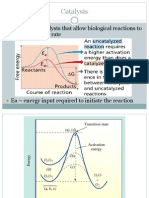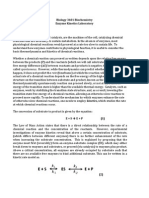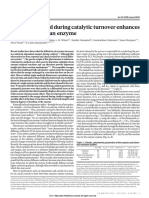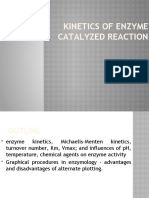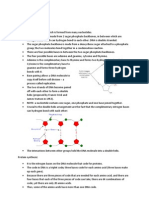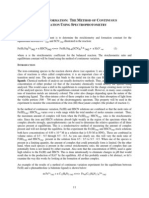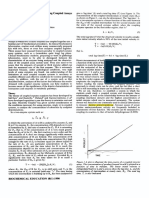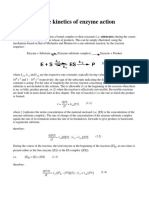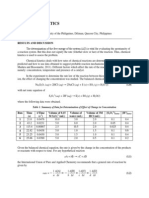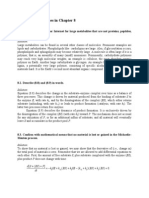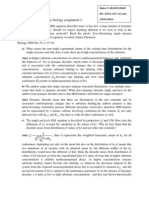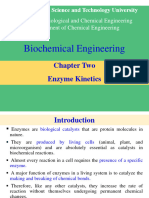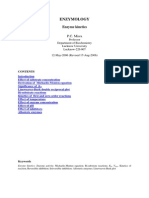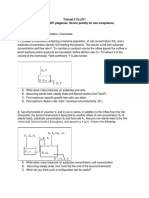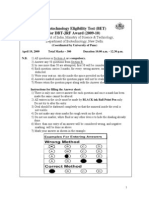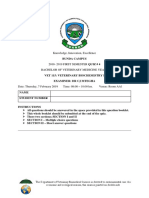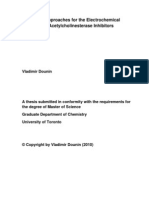Enzyme Kinetics Expts
Enzyme Kinetics Expts
Uploaded by
ChemistryIndianguyCopyright:
Available Formats
Enzyme Kinetics Expts
Enzyme Kinetics Expts
Uploaded by
ChemistryIndianguyCopyright
Available Formats
Share this document
Did you find this document useful?
Is this content inappropriate?
Copyright:
Available Formats
Enzyme Kinetics Expts
Enzyme Kinetics Expts
Uploaded by
ChemistryIndianguyCopyright:
Available Formats
Enzyme Kinetics
Timothy Chen, M.S., Jorge Ramos, Ph.D.
ENZYME KINETICS [APPLICATION OF UV-VIS SPECTROMETRY] Enzymes are macromolecules that, like all catalysts, speed up the rate of a chemical reaction without being used up in the process. The rate at which an enzyme works is influenced by several factors such as substrate concentration, temperature, pH and the presence of inhibitors. The substrate concentration factor can be explained in terms of collision theory: the more substrate molecules available, the quicker the enzyme molecules collide and bind with them. The temperature effect can be explained in terms of collision theory within a certain temperature range: molecular motion and hence collisions between enzyme and substrate speed up as the temperature rises but as enzymes are proteins, there is an upper limit beyond which the enzyme becomes denatured and ineffective. The pH of the medium affects protein conformation because certain amino acids become protonated/deprotonated at different pH, the effect is much more pronounced if the enzyme's active site contains these types of residues. First proposed by Michaelis and Menten, the catalytic event that converts substrate to product involves the formation of a transition state. The complex that forms, when substrate and enzyme combine, is called the enzyme substrate (ES) complex.
E + S k1 <======> k-1 ES
Reaction products arise when the ES complex breaks down releasing free enzyme.
ES k2 <======> k-2 EP
Between the binding of substrate to enzyme, and the reappearance of free enzyme and product, a series of complex events must take place. For example, the ES complex must pass to the transition state (ES*); and the transition state complex must advance to an enzyme product complex (EP). The latter is finally competent to dissociate to product and free enzyme. Formation of the enzyme-substrate complex is fast and the decomposition of the complex to form products is relatively slow. In this experiment we will be concerned with the initial stages of product formation and the back reaction [E + P --> ES] can be ignored,
E + S k1 <======> k-1 ES k2 -------> k-2=0 E + P
Given the conditions, the rate of product formation (R) is,
d[P] R = ------- = k2[ES] Dt
where the quantities in parentheses are molar concentrations.
Enzyme Kinetics
Timothy Chen, M.S., Jorge Ramos, Ph.D.
In order to obtain an expression for [ES] we need to use the steady state approximation, Rate ES formation = Rate of ES destruction which means that d[ES]/dt is negligible, d[ES]/dt = k1[E][S] - k-1[ES] - k2[ES] 0 The instantaneous enzyme concentration [E] is not known as a function of time but an expression for it can be obtained as follows: because the enzyme is not being destroyed its total concentration [E]T is constant, the enzyme is either free [E] or bound [ES], [E]T = [E] + [ES] Using kindergarten algebra, the steady state equation can be rewritten, k1{[E]T-[ES]}[S] = k-1[ES] + k2[ES] Defining Km as (k-1 + k2)/k1 and solving for [ES] we get,
[E]T[S] [ES] = ---------[S] + Km
and the rate of product formation is,
k2[E]T[S] Rate = k2[ES] = ---------[S] + Km
Enzyme Kinetics
Timothy Chen, M.S., Jorge Ramos, Ph.D.
Given the conditions, if [S] is very low the kinetics are first-order with respect to [S],
k2[E]T[S] R = ---------Km
If [S] is very large, the reaction becomes zero-order with respect to [S] and the rate approaches its limiting value, R = k2[E]T Then the quantity k2 becomes the turnover number: the number of substrate molecules converted into product per unit time when the enzyme is saturated with substrate.
Very high substrate concentrations overwhelm the enzyme: all active sites are occupied, and the addition of further substrate does not increase the reaction rate. The plot of Rate versus [S] above is not linear. Before the modern era of nonlinear curvefitting on computers, this nonlinearity could make it difficult to estimate Km and Rmax accurately. Therefore, several researchers developed linearizations of the MichaelisMenten equation, such as the LineweaverBurk plot and the Eadie-Hofstee diagram. The LineweaverBurk plot or double reciprocal plot is a common way of illustrating kinetic data. This is produced by taking the reciprocal of both sides of the Michaelis Menten equation,
1 --- = R Km -------Rmax[S] 1 ---Rmax
Enzyme Kinetics
Timothy Chen, M.S., Jorge Ramos, Ph.D.
The LineweaverBurk plot skews the importance of measurements taken at low substrate concentrations and, thus, can yield inaccurate estimates of Rmax and Km. A more accurate linear plotting method is the Eadie-Hofstee plot. In this case, Rate is plotted against Rate/[S].
R --- = [S] k2[E]T ----Km R ---Km
Enzyme Kinetics
Timothy Chen, M.S., Jorge Ramos, Ph.D.
Inhibitors affect the catalitic power of enzymes by binding to the same site as the substrate (competitive inhibition) or binding to some other site on the enzyme (noncompetitive inhibition). Irreversible inhibitors bind to the enzyme and destroy the active site, or otherwise screw the protein. Suicide inhibitors, a special class of such inhibitors, are activated by the normal catalytic activity of the enzyme, but form an intermediate that binds to and destroys the active site. Irreversible inhibitors bind tightly (often covalently) to the enzyme and cannot be removed by dialysis. They include such things as nerve gases (Sarin, DIPF, Tabun) and insecticides (Malathion). KINETIC ANALYSIS OF TYROSINASE Tyrosinase (EC 1.14.18.1) is a copper-containing enzyme present in plant and animal tissues that catalyzes the production of melanin and other pigments from tyrosine by oxidation. The three-dimensional structure of Tyrosinase from Streptomyces castaneoglobisporus exhibits a hydrophobic pocket adjoining a binuclear copper active site. One of the Copper atoms binds to the -nitrogen atoms of His38, His54, and His63. The other copper atom binds to the -nitrogen atoms of His190, His194, and His216. One probable catalytic mechanism has O2 getting trapped between the two copper atoms as one of the first steps in the reduction of molecular oxygen to water.
The active site of Tyrosinase. Each copper atom (gold sphere) is coordinated by three nitrogen donor atoms from histidine residues (shown in stick mode) In this experiment, tyrosinase will be used to catalyze the conversion of DL-DOPA to hallachrome, a red compound which absorbs visible radiation at 475 nm,
Enzyme Kinetics
Timothy Chen, M.S., Jorge Ramos, Ph.D.
The reaction rate will be monitored by measuring the increase in absorbance at this wavelength that occurs as the reaction proceeds. The rate of the reaction will be determined for several different concentrations of substrate (DL-DOPA) and enzyme (tyrosinase) with the pH, and temperature held constant for all runs. Hallachrome is not the initial product of the oxidation of DOPA. However, the oxidation of DOPA to DOPA quinone is the rate determining step in the reaction sequence, and subsequent reactions occur very rapidly. Thus, the rate of formation of hallachrome is almost the same as the rate of formation of DOPA quinone.
REQUIRED MATERIALS AND APPARATUS -spectrophotometer with computer interface or spectrophotometer + timer -1.00 cm path lenght cells -0.25 cm or small capacity quartz cells -1000 L pipets able to deliver at 100 L increments -Sodium Phosphate Buffer Materials -Tyrosinase 100 units/mL -L-DOPA 2mg/mL in Phosphate Buffer -Thiourea 10-3 M Phosphate Buffer -Sodium Benzoate in Phosphate 3 X 10-3 M Buffer EXPERIMENTAL PROCEDURE Enzyme assays will be carried out on solution mixtures of 3.0 mL total volume. To prepare these solution mixtures, you will mix a precise volume of a stock solution of Tyrosinase with a precise volume of other solutions. For better results, solutions should be used the same day. If storage is required, store at 4 0 for no longer than three days and allow to warm to room temperature prior to use. Compute the total enzyme concentration for the stock solution. An accurate measurement can be obtained from the extinction coefficient of tyrosinase at 280 nm. The
Enzyme Kinetics
Timothy Chen, M.S., Jorge Ramos, Ph.D.
Absorbance of a 1% (w/v) solution of pure tyrosinase 24.9 in a 1 cm cell. Using BeerLambert's law, the enzyme concentration is computed from a simple ratio,
C1% C ---------- = --------24.9(l cm) A(l)
Where C is the concentration of unknown solution and l is the path lenght of the cell being used. In order to collect data for one data set, the required quantity of DL-DOPA will be dissolved in a buffer solution in a cuvet and the reaction initiated by addition of the enzyme. The cuvet is then placed in a spectrometer, and the percent transmittance read every 15 seconds for 3 minutes. The reaction rate for the data set (hallachrome/second) can be determined by: [1] calculating the slope of the line which is nearly linear for the first part of the data set (absorbance/second); [2] and dividing the slope by the molar absorptivity for hallachrome (5.00 X 103 M-1cm-1 at 475 nm) multiplied by the sample path length.
C = A ------------------5.00 X 103 M-1cm-1
Catalytic Activity Assay
Reagent Buffer L-DOPA Tyrosinase 1 1.45 1.50 0.05 2 1.40 1.50 0.10 3 1.30 1.50 0.20 4 1.10 1.50 0.40 5 0.70 1.50 0.80
Michaelis-Menten Parameters
Reagent Buffer L-DOPA Tyrosinase 1 2.60 0.20 0.20 2 2.40 0.40 0.20 3 2.00 0.80 0.20 4 1.80 1.00 0.20 5 1.60 1.20 0.20
Inhibition of Tyrosinase
Reagent Buffer L-DOPA Inhibitor Tyrosinase 1 2.50 0.20 0.10 0.20 2 2.30 0.40 0.10 0.20 3 1.90 0.80 0.10 0.20 4 1.70 1.00 0.10 0.20 5 1.50 1.20 0.10 0.20
DATA PROCESSING [1] Plot absorbance as a function of time, draw the best straight line and determine the slope for all assays. [2] Convert from Absorbance units to molar concentrations using the Beer-Lambert law and the extinction coefficient of Hallachrome.
Enzyme Kinetics
Timothy Chen, M.S., Jorge Ramos, Ph.D.
[3] For the assay set where [E] is changing, plot the reaction rate as a function of enzyme concentration. Report the specific activity of the enzyme (mol of product/min/mg of enzyme). Estimate enzyme's turnover number using your data and the molar mass of Tyrosinase (approx. 47 kDa). [4] For the assay set where [S] is changing, make an Eadie-Hofstee plot of the data. Alternatively, you can do a double reciprocal plot of the data. [5] Report Km, RateMAX, and the enzyme's turnover number. Compare the enzyme's turnover number with the estimate obtained using the specific activity. -Based on the Michaelis-Menten parameters obtained from the Tyrosinase inhibition assays, explain what kind of inhibitor compound X is. [6] Download the structure of Tyrosinase [PDB code 1WX2], identify the residues in the active site. Based on your knowledge of ligand binding and protein structure, explain how the substrate binds the active site and propose a catalytic mechanism. [7] Submit all graphs with your report.
THE GLUCOSE OXIDASE/HORSERADISH PEROXIDASE SYSTEM Glucose oxidase is a dimeric protein with a molecular weight of 160 kDa, containing one tightly bound flavin adenine dinucleotide (FAD) per monomer as cofactor. The apoenzyme missing the FAD cofactor is not biocatalytically active, but it can be reconstituted with native or artificially modified FAD cofactor. The catalytic cavity includes Asp 584, Tyr 515, His 559 and His 516 which might be involved in the catalytic reaction or substrate binding. Additional contacts to the substrate might be formed by Phe 414, Trp 426 and Asn 514. Like other carbohydrate binding modules, aromatic residues are essential components of the catalytic cavity.
Active site of Glucose Oxidase
Enzyme Kinetics
Timothy Chen, M.S., Jorge Ramos, Ph.D.
Glucose oxidase catalyzes the oxidation of -D-Glucose by molecular oxygen to Gluconolactone,
Here, two protons and electrons are transferred from -D-glucose to the enzyme yielding -gluconolactone, then the enzyme is oxidized by molecular oxygen yielding hydrogen peroxide. Finally -gluconolactone can be hydrolysed non-enzymatically to gluconic acid. The hydrogen peroxide produced in this process is a good oxidizing agent, and in the presence of the reducing agent, 2,2'-azino-bis(3-ethylbenzthiazoline-6-sulfonic acid), abbreviated ABTS, it is catalytically reduced to water by the enzyme, horseradish peroxidase (HRP). The oxidized form of ABTS, ABTS+, absorbs strongly at 725 nm. The extinction coefficient of the dye at this wavelength is 1.9 X 104 M-1cm-1. Thus the kinetics of glucose oxidase catalyzed glucose oxidation can be studied by monitoring the absorbance at 725 nm. The oxidised dye also exhibits an absorption maximum at a wavelength of 415 nm where the extinction coefficient is 3.6 X 104 M-1cm-1. REQUIRED MATERIALS AND APPARATUS -spectrophotometer with computer interface or spectrophotometer + timer -2-2'-azino-bis(3-ethylbenzthiazoline-6-sulfonic acid)(Sigma catalog #A-1888)A -Analytical grade -D-glucose and D-mannose -0.25 cm path lenght or small capacity cells [<2 mL] -1000 L pipets able to deliver at 100 L increments -Sodium Phosphate Buffer Materials -Glucose oxidase (Sigma catalog #G-6125)B -Horseradish peroxidase (Sigma catalog #P-6140)B A Can be replaced with o-Dianisidine Reagent (Sigma catalog #D-2679) B Can be replaced with lyophilizate Enzyme Reagent (Sigma catalog #G-3660) EXPERIMENTAL PROCEDURE Enzyme assays will be carried out on solution mixtures of 1.0 mL total volume. To prepare these solution mixtures, you will mix a precise volume of a stock solution of 9
Enzyme Kinetics
Timothy Chen, M.S., Jorge Ramos, Ph.D.
glucose oxidase with a precise volume of other solutions. For better results, solutions should be used the same day. If storage is required, store at 4 0 for no longer than three days and allow to warm to room temperature prior to use. Prepare a 0.1 M sodium phosphate buffer and adjust to pH 7.0 Prepare an ABTS solution with a concentration of approximately 35 mM. As a rule of thumb, 20 mg (0.02 g) of ABTS reagent dissolved in 1.0 mL of deionized water will make a 35 mM ABTS solution. Prepare a HRP solution with a concentration of 25 Sigma units of HRP per mL. The Glucose oxidase stock solution should be about 5 Sigma units per mL. But this does not mean you should use this concentration. You should do a test run to see if this concentration gives an absorbance rate of change you can measure, if the solution changes color too fast or too slow you will not be able to get any meaningful data. The sugar (glucose and mannose) stock solutions should be 1.0 M. Lets define assay 1/1 as consisting of the following amounts of stock solutions: 600 of buffer, 100 of glucose oxidase, 100 of ABTS, 100 of HRP, and 100 of glucose. This gives final concentrations for glucose oxidase, ABTS, HRP, and glucose which are 10 times lower than the initial stock concentrations. Now you have to prepare assays where the enzyme concentration is varied, define assay 1/1 as having enzyme concentration [E] and substrate (glucose) concentration [S], then you could prepare solutions that vary by some factor which is accessible with the Micropipets provided. 1 2 3 4
[E] [3E/4] [E/4] [E/8] 1 2 3 4
[S] [3S/4] [S/4] [S/8] Say you want to prepare assay 2. For that you would mix 625 L of buffer, 100 L of glucose oxidase stock, 100 L of ABTS, 100 L HRP stock, and 75 L of glucose stock. The substitution to go from 1 to 2 is, 100 L of glucose stock --> 75 L of glucose stock + 25 L of buffer. Similarly, the substitution to go from 1 to 3 is, 100 L of glucose oxidase stock --> 25 L of glucose oxidase stock + 75 L of buffer. You get the idea, there are many possible variations for this experiment. The limiting factor is the volume increments that the Micropipets can deliver accurately. The second week of the experiment, replace glucose with mannose. You will need about 2 mL of this solution and it has to be prepared on week one to allow for isomer equilibration. The concentration of glucose oxidase should be about 50-fold higher. 10
Enzyme Kinetics
Timothy Chen, M.S., Jorge Ramos, Ph.D.
Recall that glucose oxidase is specific for glucose and will exhibit slow oxidation rates for other sugars. For each assay, monitor the absorbance for the first six minutes of the reaction. For spectrophtometers with a computer interface, set the machine to time monitoring mode and stop after 6 min. If the spectrophometer does not have a computer interface, record the absorbance at 20 sec intervals for 6 min. This is equivalent to monitoring the initial stages of product formation and the Michaelis-Menten plot will be linear during that time interval. THE G3660 REAGENT CAPSULE & THE SIGMA UNITS The Glucose Oxidase [a number of Sigma Units] and the Horseradish Peroxidase are contained in a capsule along with buffer salts [lyophilizate]. The Sigma Units are also a measure of activity per mg of enzyme: Sigma Unit = Units/mg of Glucose Oxidase The reagents in the capsule are medium grade. Just to give you an idea of what this means, the high grade enzyme has an activity of more than 200 Units/mg. A reasonable estimate of the enzyme in the capsule is about 20 Units/mg of Glucose Oxidase. Since the capsule contains 500 Units, we get 500 Units / [20 Units/mg of Glucose Oxidase] = 25 mg of Glucose Oxidase Then you can convert Units to mg using, 1 Unit = 0.05 mg of Glucose Oxidase The instructor will place one capsule of Glucose Oxidase/Horseradish Peroxidase reagent [Sigma #G-3660] in a 25 mL volumetric flask to make a Master Solution for the whole class. The capsule contains 500 Units of catalytic strength which gives, Master Solution = 500 Units / 25 mL = 20 Units/mL For each week of the experiment, you will need about 20 Units. The enzyme seems to have moderate speed with a stock solution of 5 Units/mL. Thus you can take 1 mL of the Master Solution in a mini beaker or vial and add 3 mL of deionized water to make your 5 Unit/mL stock solution. If you use 100 L of your stock solution for a 1 mL assay, the working concentration of enzyme would be 1 Unit/mL. Then you can use 200 L to make trial 2 equal to 2 Units/mL, and so on. For the substrate [Glucose] variation, recall that you are using 100 or 200 L of 1.0 M Glucose. That makes your working concentration 0.1 or 0.2 M, which is high enough NOT to affect the reaction rate. Thus you should dilute the 1.0 M solution. You can take 1 mL of the 1.0 M solution and add 4 mL of deionized water to make a 0.2 M Glucose. 2,2'-azino-bis(3-ethylbenzthiazoline-6-sulphonic acid) ABTS (green dye) The dye works fine if the stock solution is about 30-40 mM. We want to use an amount we can measure accurately in the analytical balance. We can take 0.5 g of ABTS and
11
Enzyme Kinetics
Timothy Chen, M.S., Jorge Ramos, Ph.D.
dissolve in 25 mL of deionized water. Each assay will use 100 L of dye, so this will be enough for the whole class. ABTS [diammonium salt] weights 548.68 g/mol which gives, [0.5 g / 548.68 D] / 25 X 10-3 L = 36.45 X 10-3 M = 36.45 mM
EXTINCTION COEFFICIENT OF O-DIANISIDINE Hydrogen peroxide reacts with o-dianisidine in the presence of peroxidase to form a colored product. Oxidized o-dianisidine reacts with sulfuric acid to form a more stable colored product.
The modifications to the experimental procedure are if using o-dianisidine as the dye are: The reaction will be monitored by measuring the absorbance at a different wavelenght. The stoichiometry of the overall reaction involves a two-electron transfer from glucose to o-dianisidine [1:1 ratio]. For our enzyme kinetics experiment we do not need to use sulfuric acid. Instead, we can measure the absorbance of the brown colored oxidized o-dianisidine as it is generated. An absorbance wavelenght scan indicated that the oxidized o-dianisidine absorbs strongly at 440 nm. You could use a Beer-Lambert standard curve to figure out the extinction coefficient of o-dianisidine at this wavelenght. One way is to prepare standard glucose solutions, let the reaction go to completion and measure the absorbance. A group of students tried something different: Four assays were done with high enzyme and substrate concentration. The concentration of the o-dianisidine dye was kept low. It is assumed that the dye will be used up completely. This means that the dye is the limiting reagent and the absorbance at 440 nm will be directly related to its concentration. We used the molar mass of o-dianisidine (244.29 g/mol) and the dilution factor to compute concentration C = 5.125 X 10-7.
CONC C X 0 C X 0.25 C X 0.50 C X 0.75 C X 1.00 ABSORBANCE 0 0.27 1.05 1.77 2.15
12
Enzyme Kinetics
Timothy Chen, M.S., Jorge Ramos, Ph.D.
From the slope, the extinction coefficient is 4.25 X 106 M-1. Thus to go from Absorbance to molar concentration you use:
Absorbance Molar Concentration = --------------4.25 X 106 M-1
Thus the Absorbance units per second that you got from the spectrophotometer output become molar concentration per unit time (seconds). To convert the molar concentrations (mol/L) to moles (n) just multiply by the assay volume,
n = [mol/L] X 1 X 10-3 L
Because the assay volume is 1 mL. DATA PROCESSING [1] Compute the total enzyme concentration for the stock solution. An accurate measurement can be obtained from the flavin extinction coefficient (1.4 X 104 M-1cm-1) at 450 nm. Alternatively, you can use the definition of one Sigma unit: one unit will oxidize 1.0 mole of -D-Glucose per min at pH 5.1 and 35 0. [2] Plot absorbance as a function of time, draw the best straight line and determine the slope for all assays. [3] Convert from Absorbance units to molar concentrations using the Beer-Lambert law and the extinction coefficient of ABTS. The stoichiometry of the reaction is two molecules of ABTS oxidized for every molecule of glucose oxidized. [4] For the assay set where [E] is changing, plot the reaction rate as a function of enzyme concentration. Report the specific activity of the enzyme (mol of product/min/mg of enzyme). Estimate enzyme's turnover number using your data and the molar mass of Glucose Oxidase (160 kDa). [5] For the assay set where [S] is changing, make an Eadie-Hofstee plot of the data. Alternatively, you can do a double reciprocal plot of the data. [6] Report Km, RateMAX, and the enzyme's turnover number. Compare the enzyme's turnover number with the estimate obtained using the specific activity. [7] The pH of the reaction mixture was 7.0 at all times. How would the oxidation rate change if the pH of the buffer was acidic? basic? Recall that (a) the initial product of glucose oxidation is D-glucono-1,5-lactone, a weak competitive inhibitor of Glucose Oxidase and (b) the native protein is acidic having an isoelectric point (pI) of 4.2. [8] Download the structure of glucose oxidase [PDB code 1GAL], identify the residues in the active site. Based on your knowledge of ligand binding and protein structure, explain why the enzyme oxidized mannose is at a much slower rate than glucose. [9] Submit all graphs with your report.
13
You might also like
- Enzyme KineticsDocument13 pagesEnzyme KineticsalicjadzNo ratings yet
- Enzyme Kinetics: Michael-Menten ApproachDocument19 pagesEnzyme Kinetics: Michael-Menten ApproachAryo Adi PrasetyoNo ratings yet
- Nonclassical Chemical Kinetics For Description of Chemical Fluctuation in A Dynamically Heterogeneous Biological SystemDocument8 pagesNonclassical Chemical Kinetics For Description of Chemical Fluctuation in A Dynamically Heterogeneous Biological SystemIshwar ChandraNo ratings yet
- Enzyme and Acid - Base CatalysisDocument64 pagesEnzyme and Acid - Base Catalysisbinseung skzNo ratings yet
- Slide Biop 6-Enz KinDocument19 pagesSlide Biop 6-Enz KinAri FaisalNo ratings yet
- Slide Biop Enz KinDocument19 pagesSlide Biop Enz KinFahmi Ramadhan PutraNo ratings yet
- Immobilized Enzyme ReactorsDocument33 pagesImmobilized Enzyme ReactorsRAKESH V RNo ratings yet
- Factors AffectingDocument11 pagesFactors Affectingshekinah656No ratings yet
- Experiment: KinieticsDocument9 pagesExperiment: KinieticsJoey PabalinasNo ratings yet
- Enzymes - Michael L. ShulerDocument23 pagesEnzymes - Michael L. ShulerAndrésFelipeQuirogaMirandaNo ratings yet
- Lecture 3 Notes - EnzymologyDocument9 pagesLecture 3 Notes - EnzymologyYi Gong100% (3)
- BS 3Document60 pagesBS 3himanshu_agraNo ratings yet
- MIT5 07SCF13 Lec7 8Document19 pagesMIT5 07SCF13 Lec7 8Ruben RodriguezNo ratings yet
- Chem 40 Enzyme KineticsDocument85 pagesChem 40 Enzyme KineticsJustine Grace Mariano100% (1)
- BCH 304 EnzymologyDocument5 pagesBCH 304 Enzymologyrachealjames4466No ratings yet
- Biology 3601 Biochemistry Enzyme Kinetics Laboratory BackgroundDocument5 pagesBiology 3601 Biochemistry Enzyme Kinetics Laboratory Backgroundkgeorges27No ratings yet
- Enzyme KineticsDocument23 pagesEnzyme Kinetics1DS19CH011 Jashwanth C RNo ratings yet
- Enzyme Kinetics PDFDocument11 pagesEnzyme Kinetics PDFNati A. AlemuNo ratings yet
- Lecture 7 (MT Resistances in Immobilized Enzyme)Document21 pagesLecture 7 (MT Resistances in Immobilized Enzyme)sanyukta sinha100% (1)
- Riedel2014 CatalasaDocument13 pagesRiedel2014 CatalasaVicente Salinas BNo ratings yet
- Michaelis Menton EquationDocument13 pagesMichaelis Menton EquationJawadNo ratings yet
- 10-11, Kinetics of Enzyme Catalyzed ReactionDocument34 pages10-11, Kinetics of Enzyme Catalyzed ReactionS. Ansary100% (1)
- EnzymesDocument118 pagesEnzymesNaeem HananatNo ratings yet
- jp804046eDocument7 pagesjp804046eLê TrangNo ratings yet
- F334 - The Thread of LifeDocument16 pagesF334 - The Thread of LifeBecky TenneyNo ratings yet
- 2 Bioprocess Engineering CH 2Document54 pages2 Bioprocess Engineering CH 2Fasil ManNo ratings yet
- EnzomologyDocument26 pagesEnzomologyToga Brandon100% (1)
- The Method of Continuous Variation Using Spectrophotometry PDFDocument4 pagesThe Method of Continuous Variation Using Spectrophotometry PDFnawal2007No ratings yet
- Hammet and Taft EquationsDocument12 pagesHammet and Taft Equationszdhother82No ratings yet
- Lecture 12 - Enzyme Kinetics IDocument30 pagesLecture 12 - Enzyme Kinetics IThomas Jones50% (2)
- Coupled Assay Discsusion and LabDocument3 pagesCoupled Assay Discsusion and Labteam TSOTARENo ratings yet
- MetabolismDocument27 pagesMetabolismAnum RasoolNo ratings yet
- UTAR Chem Lab 1 Full Report Exp17Document4 pagesUTAR Chem Lab 1 Full Report Exp17Izykiel EdwardNo ratings yet
- Simple Kinetics of Enzyme ActionDocument7 pagesSimple Kinetics of Enzyme ActionRavindra Mani TiwariNo ratings yet
- Chemical KineticsDocument9 pagesChemical KineticsyugimotuoNo ratings yet
- Solutions Chapter8Document25 pagesSolutions Chapter8Fábio RamalhoNo ratings yet
- L11 Enzyme KineticsDocument10 pagesL11 Enzyme KineticsanaNo ratings yet
- Enzyme Problem SetDocument5 pagesEnzyme Problem SetGiaFelicianoNo ratings yet
- Cre 1Document52 pagesCre 1Jayakaran PachiyappanNo ratings yet
- Enzymes: Indian Institute of Technology PatnaDocument22 pagesEnzymes: Indian Institute of Technology PatnaHritik KumarNo ratings yet
- Enzyme KineticsDocument10 pagesEnzyme KineticsQuenneBelocuraNo ratings yet
- Determination of EnzymesDocument8 pagesDetermination of EnzymesUsman GhaniNo ratings yet
- Lab02 PDFDocument12 pagesLab02 PDFSiddharth KumraNo ratings yet
- CH 7 Kinetics and RegulationDocument8 pagesCH 7 Kinetics and Regulationcococat015No ratings yet
- Molecular Systems Biology Assignment 2: Thus It Represents The Weighted Harmonic Mean ofDocument3 pagesMolecular Systems Biology Assignment 2: Thus It Represents The Weighted Harmonic Mean ofArjun KumarNo ratings yet
- Brown Robertson PDFDocument8 pagesBrown Robertson PDFParth ShahNo ratings yet
- Unit - 2 Kinetics of Enzyme Catalysed ReactionsDocument31 pagesUnit - 2 Kinetics of Enzyme Catalysed Reactionstaliaasif1No ratings yet
- Teknik ReaksiDocument21 pagesTeknik ReaksiAhmadi FachryNo ratings yet
- Kinetics of EnzymesDocument2 pagesKinetics of EnzymesJohnNo ratings yet
- Enzyme Kinetics - Lab Manual 02-16-09 HMDocument10 pagesEnzyme Kinetics - Lab Manual 02-16-09 HMFoudiKarimNo ratings yet
- Enzyme CatalysisDocument65 pagesEnzyme Catalysissushant100% (1)
- 2 Biochemical Engineering CH 2Document54 pages2 Biochemical Engineering CH 2Fasil ManNo ratings yet
- KineticsDocument26 pagesKineticsMelissa M. Abansi-BautistaNo ratings yet
- Reactive Oxygen Species: Signaling Between Hierarchical Levels in PlantsFrom EverandReactive Oxygen Species: Signaling Between Hierarchical Levels in PlantsFranz-Josef SchmittNo ratings yet
- Rates and Equilibria of Organic Reactions: As Treated by Statistical, Thermodynamic and Extrathermodynamic MethodsFrom EverandRates and Equilibria of Organic Reactions: As Treated by Statistical, Thermodynamic and Extrathermodynamic MethodsNo ratings yet
- Chemesthesis: Chemical Touch in Food and EatingFrom EverandChemesthesis: Chemical Touch in Food and EatingShane T. McDonaldNo ratings yet
- Edited - Chapter 6 Test BankDocument18 pagesEdited - Chapter 6 Test BankRod De Guzman100% (1)
- The Three Laws of ThermodynamicsDocument14 pagesThe Three Laws of ThermodynamicsCheivy SolimanNo ratings yet
- Laccase MXeneDocument12 pagesLaccase MXenePrativa MNo ratings yet
- Transient Growth KineticsDocument14 pagesTransient Growth KineticsCeeEeeNo ratings yet
- Enzymes ProbsDocument21 pagesEnzymes ProbsAnonymous sVNvV7Q100% (1)
- Description and Capability of KinCalc+Supasim Mar08Document13 pagesDescription and Capability of KinCalc+Supasim Mar08RafaelNo ratings yet
- 1.5 Enzyme Kinetics 2Document25 pages1.5 Enzyme Kinetics 2Astra BeckettNo ratings yet
- EnzymeKinetics by P.C. Misra Professor, Department of Biochemistry Lucknow University, Lucknow-226 007Document21 pagesEnzymeKinetics by P.C. Misra Professor, Department of Biochemistry Lucknow University, Lucknow-226 007Dr. SHIVA AITHALNo ratings yet
- Lecture Note - Enzyme InhibitorDocument10 pagesLecture Note - Enzyme InhibitorBright ChimezieNo ratings yet
- BiochemprintfinalDocument14 pagesBiochemprintfinalJomhel CalluengNo ratings yet
- M.tech (Chem) R13Document54 pagesM.tech (Chem) R13Siva Jagadish Kumar MNo ratings yet
- Ebook SPR Nicoya Nutermia 2019Document17 pagesEbook SPR Nicoya Nutermia 2019Juan Pablo Lopez CooperNo ratings yet
- Week 2 - Enzyme Kinetics All - v2 - 3slide HandoutsDocument14 pagesWeek 2 - Enzyme Kinetics All - v2 - 3slide HandoutsFizza HussainNo ratings yet
- Journal of Hazardous Materials: Devlina Das, D. Charumathi, Nilanjana DasDocument12 pagesJournal of Hazardous Materials: Devlina Das, D. Charumathi, Nilanjana DasMARIA PAULA PORRAS ARGUELLONo ratings yet
- Lecture 2 - Cell Growth and Cell Cultivation (Batch Culture)Document64 pagesLecture 2 - Cell Growth and Cell Cultivation (Batch Culture)honeylet tayactacNo ratings yet
- ACRE2a Non Elementary Reaction Kinetics RevDocument53 pagesACRE2a Non Elementary Reaction Kinetics RevRathish RagooNo ratings yet
- Lecture 7 (MT Resistances in Immobilized Enzyme)Document21 pagesLecture 7 (MT Resistances in Immobilized Enzyme)sanyukta sinha100% (1)
- Enzymes CC LecDocument4 pagesEnzymes CC LecGian Franco ApesNo ratings yet
- Pharmacokinetics and PharmacodynamicsDocument12 pagesPharmacokinetics and PharmacodynamicsDrVinod Kumar Goud VemulaNo ratings yet
- Modelling Cell Growth: Cellular Kinetics and Associated Reactor DesignDocument34 pagesModelling Cell Growth: Cellular Kinetics and Associated Reactor DesignRhea FayeNo ratings yet
- MLAB 2401: Clinical Chemistry Keri Brophy-Martinez: Enzymes: OverviewDocument30 pagesMLAB 2401: Clinical Chemistry Keri Brophy-Martinez: Enzymes: Overviewslikest01No ratings yet
- Biochem MidTerm Exam Apr. 03.2023Document6 pagesBiochem MidTerm Exam Apr. 03.2023Michelle MariposaNo ratings yet
- Tutorial 2 CLL271 Please DO NOT Plagiarise. Severe Penalty For Non-Compliance. ReviewDocument3 pagesTutorial 2 CLL271 Please DO NOT Plagiarise. Severe Penalty For Non-Compliance. ReviewCuriousNo ratings yet
- Enzymes: OutlineDocument10 pagesEnzymes: OutlineManila MedNo ratings yet
- DBT BET Question Paper 2009 With Answer KeyDocument22 pagesDBT BET Question Paper 2009 With Answer KeyAbhay Kumar100% (3)
- Vet 115 Quiz 4Document14 pagesVet 115 Quiz 4Chiku MteghaNo ratings yet
- Enzyme Assays and KineticsDocument12 pagesEnzyme Assays and KineticsKNTNo ratings yet
- Kinetic Analysis of Sodium Gluconate ProductionDocument10 pagesKinetic Analysis of Sodium Gluconate ProductionAdriana Lucia NavarroNo ratings yet
- Dounin Vladimir V 201011 MSC ThesisDocument86 pagesDounin Vladimir V 201011 MSC ThesisIvaylo MarinovNo ratings yet
- BiochemistryDocument29 pagesBiochemistryamarizol_4124995No ratings yet




